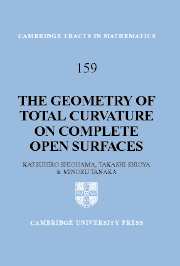Book contents
4 - The cut loci of complete open surfaces
Published online by Cambridge University Press: 14 August 2009
Summary
The definition of the cut locus was introduced by Poincaré ([68]), and he first investigated the structure of the cut locus of a point on a complete, simply connected and real analytic Riemannian 2-manifold. Myers ([60, 61]) determined the structure of the cut locus of a point in a 2-sphere and Whitehead [107] proved that the cut locus of a point on a complete two-dimensional Riemannian manifold carries the structure of a local tree. In this chapter we will determine the structure of the cut locus and distance circles of a Jordan curve in a complete Riemannian 2-manifold and will prove the absolute continuity of the distance function of the cut locus.
Preliminaries
Throughout this chapter (M, g) always denotes a complete connected smooth two-dimensional Riemannian manifold without boundary. Let γ : [0, ∞) → M be a unit-speed geodesic. Note that any geodesic segment γ : [0, a) → M is extensible to [0, ∞) according to Theorem 1.7.3. If, for some positive number b, γ |[0,b] is not a minimizing geodesic joining its endpoints, let t0 be the largest positive number t such that γ |[0,t] is minimizing. Note that there always exists such a positive number t0, by Lemma 1.2.2. The point γ (t0) is called a cut point of γ (0) along the geodesic γ. For each point p on M, let C(p) denote the set of all cut points along the geodesics emanating from p.
- Type
- Chapter
- Information
- The Geometry of Total Curvature on Complete Open Surfaces , pp. 133 - 164Publisher: Cambridge University PressPrint publication year: 2003



